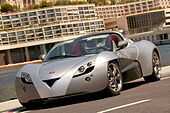Venturi Fétish
| Venturi Fétish | |
|---|---|
 | |
| Overview | |
| Manufacturer | Venturi Automobiles |
| Production | 2006 to present |
| Assembly | Monaco |
| Designer | Sacha Lakic |
| Body and chassis | |
| Class | Sports car |
| Body style | 2-seat convertible |
| Powertrain | |
| Electric motor | 220 kW, central rear mounted |
| Transmission | Differential gear reduction with limited slip, direct hold |
| Battery | 54kWh Lithium Ion Polymer |
| Range | 211 mi (340 km) |
| Dimensions | |
| Wheelbase | 2,600 mm (102.4 in) |
| Length | 3,935 mm (154.9 in) |
| Width | 1,885 mm (74.2 in) |
| Height | 1,180 mm (46.5 in) |
| Curb weight | 1,225 kg (2,701 lb) |
The Venturi Fétish is the world's first two-seater electric sports car (stated shipping in 2006). It is produced by Venturi in Monaco, and the futuristic design of the car was done by the Parisian designers Sacha Lakic. The Fétish was first introduced in concept form at the 2002 Salon International de l'Auto (International Geneva Motor Show). The manufacturer is committed to deliver 10 vehicles worldwide per year. The waiting time for the Fétish is 24 months[citation needed] and production started in 2005 with plans to end 2015, this is when the Fétish 2 is expected to hit the roads. The retail price for this car has dropped to €300,000 as of May 2007 (approx. US$400,000), VAT not included. Sales data is now available, but it is unclear if any have shipped to customers yet, estimates say Venturi has shipped 35.
Technical specifications
The 220 kW electric motor develops a power of over 300 hp (+220 kW) and a torque of 380 Nm. Accelerates from 0 to 100 km/hr in 4 seconds and attains a top speed of 200 km/h.
One other particular attraction of the car is that due to the electric traction motor, the full 380 Nm torque is available from 0 to 6,000 rpm, as opposed to the progressive delivery of an internal combustion engined car, where maximum torque is only available within certain RPM ranges.
The company specifies the car with a real range of up to 340 km. The batteries are Lithium Ion Polymer developing 54 kWh with a life-span of over 1,800 cycles, offering an 80% recharge in 3 hours with the external charge booster or 8 hours with the onboard charging system.
See also
- List of electric cars currently available
- List of production battery electric vehicles
- Lightning GT
- Tesla Roadster
- Wrightspeed X1
External links & References
| Wikimedia Commons has media related to Venturi Fétish. |
Others :
- http://www.venturiboards.com
- Finally on the roads: Venturi Fétish (26 September 2004)
- http://www.autoindex.org/news.plt?no=941
- http://www.cardesignnews.com/autoshows/2003/detroit/preview/michelin/
- Michelin displays French design at the 2003 North American International Auto Show